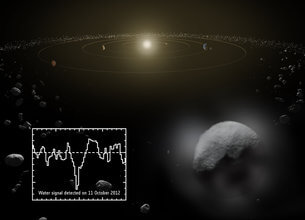Ceres is the largest asteroid, which is currently defined as a dwarf planet and is covered by a thin shell of ice. At the end of the year, NASA's DAWN spacecraft will reach it for comprehensive research

The European Space Agency's Herschel Space Telescope has discovered water vapor around Keres. This is the first time that an unequivocal identification of water vapor surrounding any object in the asteroid belt has been made.
Ceres, with a diameter of 950 kilometers, is the largest object in the asteroid belt located between the orbits of Mars and Jupiter. However, unlike most asteroids, Ceres is almost spherical and in the last decade scientists have assigned it to the category of "dwarf planets", a list that also includes Pluto.
It is estimated that Keres contains layers - most likely a rocky core and an outer shell of ice. This is important because the water ice content of asteroids has a significant impact on our understanding of the evolution of our solar system.
When the solar system was formed 4.6 billion years ago, it was too hot in the central regions, which later condensed into the rocky planets: Mercury, Venus, Earth and Mars, which lost their water due to the great heat. However, at a later stage asteroids and comets fell on them in the rain that stopped 3.9 billion years ago.
While comets are known to contain large amounts of water, the state of water in asteroids has not been known, except for a few hints in what appears to be the tail of a family of comet-like asteroids, but no definitive detection of water vapor has been obtained until now.
Data compiled by scientists who used the HIFI instrument on the Herschel Space Telescope discovered evidence of water vapor emitting from the ice surface in the spectrum of the photographs from Krass.
"This is the first time that water has been discovered in the asteroid belt and it provides proof that Keres has an icy surface and an atmosphere," says Michael Coopers from the Center for Astronomy and Space of the European Space Agency in Spain, the lead researcher of the article published in Nature.
The researchers came to the conclusion, by examining the water concentrations during the nine-hour rotation of the hook around its axis, that almost all the water vapor comes from two points on the surface. And Lawrence O'Rourke, the main researcher of the asteroid Herschel and the second author of the article explains that the emission rate is 6 kg of water vapor per second. "The simplest explanation for the production of water vapor in the hook is through the mirror. The ice heats up, turns directly into gas, and raises the surface dust with it. In this way fresh ice is exposed underneath it which will continue the process, similar to the process that takes place on comets."
The two water vapor emitting regions are about 5% darker than the average in the Hook and were formed as a result of the more efficient appearance of small reservoirs of water ice. Another alternative is active frozen volcanoes. More detailed information on Ceres is expected to arrive soon from NASA's DAWN spacecraft, which is scheduled to arrive at the dwarf planet in early 2015. The spacecraft will provide detailed mapping of the surface and monitor water activity.
"The discovery of water vapor in the hook provides new information on the distribution of water in the solar system. Since Ceres makes up about one-fifth of the total mass of the asteroid belt, the find is important not only for the study of the small bodies in the solar system, but it also makes it possible to learn about the origin of water on Earth," says Goran Filbrat, a scientist in the European Space Agency's Herschel project.

2 תגובות
Not that Herschel was exactly Jewish... Despite the name, and despite the name of his father Isaac.
Herschel - the first Jewish telescope.